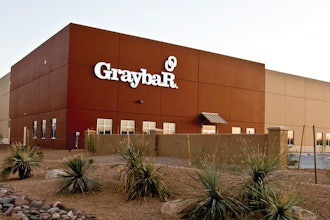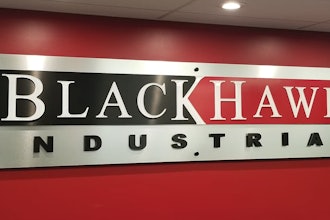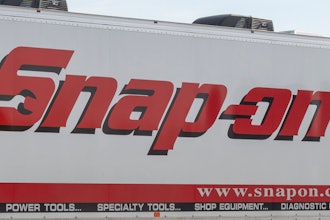As costs continue to rise, distribution centers and warehouses are looking for ways to control these costs and be more efficient.
As costs continue to rise, distribution centers and warehouses are looking for ways to control these costs and be more efficient. Innovative ways to address these issues crop up more and more from a technology standpoint, including:
- New software which allows simplified warehouse management of everything from trailer scheduling to equipment usage.
- Automation which decreases labor costs while increasing productivity.
- Facility organization that can be enhanced by utilizing all available space more effectively.
Customers are asking for access to real-time information regarding their yard, trailer, and loading dock operations, says Steve Sprunger, vice-president of sales and marketing with 4Front Engineered Solutions — a global manufacturer of safety, productivity, and environmental control products. In response to this demand, 4Front has created 4SIGHT, an intelligent software to monitor, communicate, and manage loading docks.
“The 4SIGHT technology allows customers to monitor and manage every activity that occurs once a trailer arrives at their facility,” Sprunger says. “Trailer scheduling, trailer content and location within the yard, dock status, asset tracking, loading dock security, and equipment usages and maintenance are all enhanced by implementing 4SIGHT.”
“Some customers are utilizing 4SIGHT for asset tracking and management within their organization,” he adds. Tracking the status of equipment or hardware, monitoring air pressure and bacteria control, and monitoring the location and status of interior doors to maintain temperature are just a few ways that 4SIGHT is being used.
The result is a more efficient and productive warehousing operation. With 4SIGHT, Sprunger says a customer is able to quantify a reduction in labor costs, trailer and personnel idle time, fuel consumption, demurrage charges, and security or environmental breaches, like the loss of conditioned air from a facility through a poorly sealed entrance.
“According to a recent study at PROMAT, 88 percent of companies are focusing on sustainability, but only 7 percent have thought of the loading dock as a way to save energy,” Sprunger says. He adds that 4Front has recently noticed a customer drive to increase sustainability while keeping costs at bay.
“That’s why we’ve kept our focus on creating energy-efficient, budget-friendly products that will help maximize energy savings,” he says.
A New Building
No manufacturer wants an inefficient operation, and evaluating energy-saving opportunities is a top priority for facility management. Heat loss, poor lighting, and repetitive operator tasks can all contribute to higher costs, lower productivity, and a higher rate of on-the-job injuries.
Mitch Roseburg, vice-president of marketing and product management with Kiva Systems, an automation technology supplier, says the solution is the “Kiva building.”
“Ultimately, a Kiva building means it’s a building that is quick and low-cost to set up, inexpensive to operate, and easy to change,” he says. “Kiva offers a whole new approach to warehouse automation due to its flexibility.”
Kiva’s fleet of mobile-robotic drive units enable a facility to automate the pick, pack, and ship processes. “Kiva does not require heating and lighting like human pickers, so a Kiva warehouse can utilize zone heating and lighting to more limited areas where human stations are located,” Roseburg says.
Allowing a facility to utilize zone heating and lighting to more limited areas, where human stations are located, can save a manufacturer thousands of dollars a year. The robotic drives can save workers from the heavy lifting, and from the repetitive miles of walking a picker travels every day—a necessary, but unprofitable effort for a facility without automation.
“Unlike other automated material handling systems, mobile-robotics can easily and quickly adapt to changes in product types, product velocities, order prioritization, and other operational realities,” Roseburg says. He points out that Kiva’s operator-friendly form of automation allows up to four times greater productivity than other automation approaches and has a 99.99 percent accuracy rate.
These robots are ideal for fast growing companies who aren’t able to predict where they’ll be five years down the road, as Kiva’s automation equipment doesn’t need to be completely installed upfront.
“You are not locked into a system that is bolted down,” Roseburg says. “Instead you can more practically invest only in what is needed to meet current capacity, then add as you grow.”
Kiva’s fleet of mobile-robotic drive units, moveable shelves, work stations, and control software that automate the pick, pack, and ship processes can integrate into a facility’s existing management system, and is able to grow with demand.
“The Kiva solution was designed with the flexibility necessary to handle products of all shapes and sizes from aspirin to electrical components, books to baby supplies, or fan belts to folders,” Roseburg says.
New Space
In addition to automation, manufacturers continue to develop innovative solutions to increase facility efficiency and safety. These new solutions make getting your warehouse to run as smoothly as possible continuously easier to accomplish. Wildeck, Inc. is no stranger to companies looking for ways to handle material safely and more efficiently. The largest manufacturer of industrial steel work platforms, vertical lifts, and safety guarding products in North America, Wildeck’s goal is to help manufacturers be more efficient and safer, for workers and equipment.
Keith G. Pignolet, President of Wildeck, says “utilizing overhead space is one of the smartest decisions facility planners can make. Not only is it less expensive than adding on to a building, it is more energy efficient and contributes to leaner, more productive operations.”
A custom designed industrial steel work mezzanine or a mezzanine-crane combination, the MezzCrane system, are two solutions that Wildeck offers to facility planners. This often overlooked dead space in a facility can be a cost-effective area of business expansion.
Pignolet says Wildeck is an integrated facility solution for manufacturers, providing equipment to store, move, and protect material and personnel.
“Wildeck works closely with a dedicated and experienced network of customer service-oriented dealers and systems integrators nationwide,” Pignolet says. “Our dealers and systems integrators have the knowledge and experience to evaluate a customer’s requirements— whether they want to add storage or manufacturing space with a mezzanine or add code-compliant stairs to increase plant safety.”
He adds that more ideas for new products and designs come from customers than any other source. Accessories for their core products — mezzanines, vertical reciprocating conveyors, and guarding products — are options that customers have requested they supply. Safety gates, overload protection systems, and EdgeGard are all the results of customer demand.
“Wildeck’s new product development team continually reviews customer needs and determines whether it’s something that Wildeck can manufacture and supply,” Pignolet says.
“Ideas we receive from customers are the fuel that drive Wildeck growth,” Pignolet adds, “and we don’t see that stopping any time soon.”
Taking Solutions To The Customer
Fuel and operating costs are still rising, but U.S. manufacturers are rising to the occasion. The material handling industry is getting more efficient and manufacturers are listening to customers to continue the innovation.
Spunger says 4Front, like other manufacturers, is keeping their fingers on the pulse of the material handling industry. 4Front is utilizing a mobile showroom to accomplish this, a 53-foot custom vehicle stocked with new products waiting for customer feedback.
“In addition to providing customers a unique environment to evaluate dozens of 4Front products, the trailer allows us to ‘focus group’ companies regarding the latest trends and emerging need,” Sprunger says. “Our trailer has given customers a better means of communicating their warehouse needs and we’ve used that input to accelerate our research and development.”
Says Sprunger: “We’re literally driving solutions to the warehouse.”






















